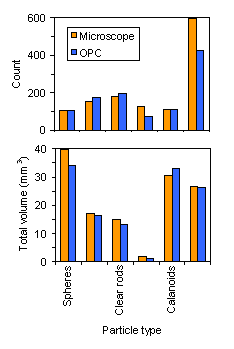 |
||||
Changes in the Pelagic Food Web of Southern Lake Michigan
The goal of this program is to characterize seasonal and spatial dynamics of nutrients and plankton in southern Lake Michigan. We seek to document recent and long-term changes in the pelagic food web and relate these changes to impacts of non-indigenous species and interannual variability in weather.
There have been tremendous changes in fisheries, the planktonic food
web, and benthos in the last three decades in Lake Michigan because of
phosphorus reduction, salmonid stocking, invasion by exotic fishes such
as alewife and by exotic invertebrates 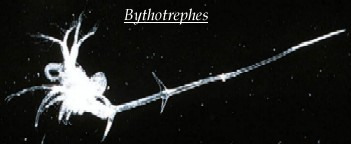 such as Bythotrephes (spiny water flea) and zebra mussels, as
well as large interannual variations driven by weather.
such as Bythotrephes (spiny water flea) and zebra mussels, as
well as large interannual variations driven by weather.
There has been concern about the decline of the commercially valuable inshore fishery for perch and the decline in a number of forage fishes important for salmon and lake trout. In addition, the quality of the nearshore has been changed by increases in nearshore benthic algae, alewives washing up on beaches, and taste and odor problems at municipal water intakes. Incredibly, Diporeia, a dominant member of the benthos and an important food for a number of fishes, has completely disappeared from the southern basin of Lake Michigan.
This project collates and expands upon earlier monitoring efforts in Lake Michigan by GLERL (1994-2000) and the University of Michigan (1972-1983) to extend the data set through 2003 extending the nearshore zone. These last observations were collected under the aegis of the Implications of Cercopagis and Bythotrephes to Alewife Recruitment and Stability of the Lake Michigan Pelagic Food Web project. With the onset of the Episodic Events Great Lakes Experiment (EEGLE web site) 1998-2001 a significant new sub-component of this program was added. We aquired a new instrument called a Plankton Survey System (+ more on PSS). We have been documenting PSS performance and exploring it's utility for mapping high-resolution spatial distribution of total suspended solids, temperature, photosynthetically active radiation, chlorophyll, and zooplankton biomass in large lakes. The PSS is towed on transects that are also sampled for zooplankton tows and nutrient data at fixed locations. Combining the discrete data with the survey data has provided a unique picture of seasonal offshore-onshore differences in nutrients and plankton abundance and community structure at different transects in southern Lake Michigan.
Comparing recent to early monitoring data from Lake Michigan
We built upon GLERL’s 1994-1998 pelagic monitoring program offshore of Muskegon, Michigan (110-m and 45-m sites labeled M110 and M45 on the Muskegon transect in Fig. 1) and the monitoring program and experimental work in the EEGLE program (1998-2000) at the St. Joseph transect (Fig. 1) to compare seasonal dynamics of plankton in at these two locations. Work was continued at all Muskegon stations (M110, M45, M15) until the end of 2003.
Particular emphasis has been focused on the Muskegon transect to explore long-term temporal changes in the pelagic food web associated with zebra mussels, alewives, and Bythotrephes. We evaluate whether these data collected at Muskegon and St. Joseph are similar enough to allow us to merge our 10-year history at Muskegon with the long-term seasonal studies (1972-1982) conducted by the University of Michigan near there and in the intakes of the Cook Power Plant.
Introducing and Evaluating the Plankton Survery System
The Plankton Survey System (PSS: optical plankton counter, CTD, and fluorometer mounted on a V-fin) was used to map horizontal and vertical distributions of plankton on the EEGLE program transects during 1998-2000.
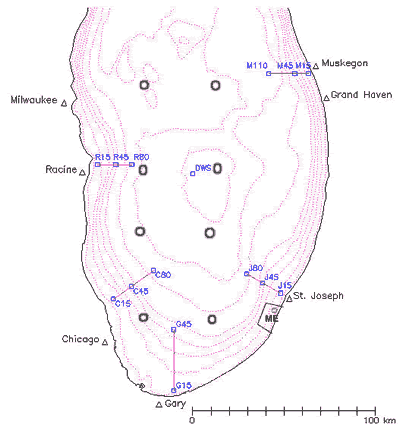
Figure 1. Location of EEGLE sampling stations and transects in southern Lake Michigan. Survey area for Evans et.al (1980) study represented by box surrounding symbol ME. Stations for Makarewicz et al. (1995) study represented by circles.
Recent Program Accomplishments
In 2005 we focused on finishing determination of biomass for critical discrete zooplankton samples; construction of an easily accessable data base, and doing analyses to explain the observed changes in 1994-2003. Particular emphasis was placed on getting Bythotrephes, Leptodora, and Cercopagis abundances, biomass, egg ratios, and other population metrics completed for all zooplankton samples collected during this period, because Bythotrephes is thought to be a major driver of zooplankton abundance and fish recruitment.
Measurements of zooplankton biomass from critical zooplankton samples collected in this project as part of the larger EEGLE (1998-2000) program and in the GLERL pelagic monitoring program of 1994-1998 are largely complete. This enables us to examine seasonal and interannual variability as they relate to nutrients, chlorophyll, Bythotrephes and alewives. This also complete studies of spatial distribution of zooplankton during the winter-spring transition for EEGLE and allows for biomass comparisons with earlier University of Michigan studies done in 1972-1982 near St. Joseph, Michigan.
As a part of these efforts we have worked with Chuck Madnejian of USGS Great Lakes Sciences Center (+ GLSC web site) to get estimates of alewife biomass. Part of the story on interannual variability relates to weather driven changes of alewife abundance and their selective feeding on zooplankton. We have also worked with Steve Pothoven who has alewife stomach contents and zooplankton abundance data, to estimate prey selection for different zooplankton, adapting methods we developed many years ago. These longer term observations will aid interpretation of Bythotrpehes and Cercopagis that we are focusing on in our Implications of Cercopagis and Bythotrephes to Alewife Recruitment and Stability of the Lake Michigan Pelagic Food Web study.
A particular concern has been the observation that the optical plankton counter (OPC) on the PSS sees more zooplankton than net tows at certain times of the year, particularly in nearshore areas. We organized a special session at the ASLO/TOS 2004 meeting to evaluate OPC function and use, and we developed criteria for identifying periods for which the OPC can be a useful tool in large lakes.- We have a publication accepted on the OPC performance in J. Geophysical Res-Oceans
- We served as guest editors for a special section on the Optical Plankton Counter for measuring zooplankton distributions in JGR-Oceans in 2005 .
Program Data Highlights
Discrete Station Zooplankton Counts Results
We have documented a rapid change from calanoid (large) copepods to cyclopoid (small) copepods during 1998-1999 and from large cladocerans (Daphnia) to small cladocerans (Bosmina) during 1998-2000 (Fig. 4). Data collected at other sites in EEGLE show this was a basin-wide change. This change coincided with a strong alewife year class.
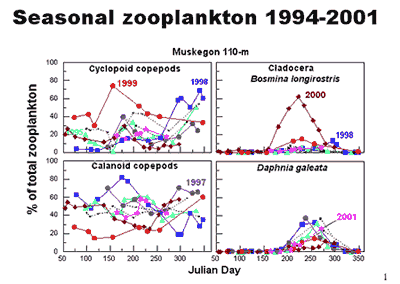
Fig. 4. Zooplankton data collected in the GLERL pelagic monitoring program (1994-998) and as a part of the EEGLE project (1998-2001)
Plankton Survey System
Comparisons between optical plankton counter (OPC) and plankton net collections of biomass for Michigan samples from the 1998-2002 showed that the OPC gave larger estimates of biomass than did the net tows, especially during the winter-spring transition. Because direct comparisons between these two methods of zooplankton enumeration and biomass estimate are very difficult to make, we sought to empirically derive an appropriate shape factor to correct for the possibility the OPC overestimates biomass, as has been reported in the literature. To help evaluate causes of discrepancies between OPC and net tows and evaluate the shape-factor question, we pumped known size distributions of zooplankton and rods through a borrowed laboratory model OPC and our own field OPC using a special circulator system we built. Our investigation, contrary to other published studies, showed that the OPC does not overestimate zooplankton biomass (at low zooplankton concentrations). Therefore, a shape factor correction should not be employed. In 2005, had a publication accepted on the OPC performance in J. Geophysical Res-Oceans (see publications listing).
Figure 5. Total count and volume of zooplankton and
particles seen by lab OPC.
PSS Transect Tow Results
PSS tows on these transects along with the discrete measurements at the stations on the transects provided a unique picture of seasonal offshore-onshore differences in nutrients and plankton abundance and community structure at different transects in southern Lake Michigan. We also did a major cruise in May that covered all transects (Chicago, Gary, Michigan City, St. Joseph, and Muskegon) to evaluate offshore-onshore patterns at a variety of sites in the southern basin (Fig. 1) outside of the plume time frame. There were tremendous differences in the nearshore areas among some of the transects. For example, chlorophyll concentration was lower and zooplankton concentration was very much lower in the nearshore area near Chicago as compared to Muskegon (Figs. 2a, 2b, 2c, 2d). These data are the first to fully span the inshore to offshore and show that inshore regions of different parts of the southern basin are very different.
All these features have been missed in other monitoring programs. They have focused on monthly coverage of a limited region of the inshore to offshore in the Cook Power Plant study (see Fig. 1 for Evans site), spring and fall sampling of the epilimnion at EPA offshore sites (see Makarewicz et al. stations in Figure 1) and monthly sampling in GLERL's program at M110 and M45 (Fig. 1).
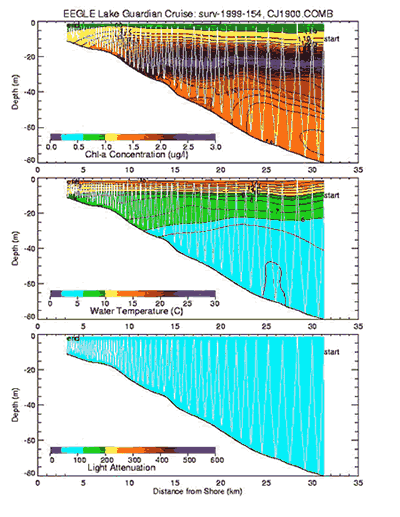
Figure 2A. Chicago transect in early June 1999: Chlorophyll fluorescence, water temperature, and light attenuance. White sinusoidal lines on panels are PSS traces.
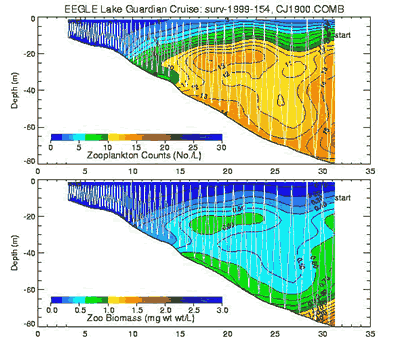
Figure 2B. Chicago transect in early June 1999: Zooplankton number concentration and biomass.
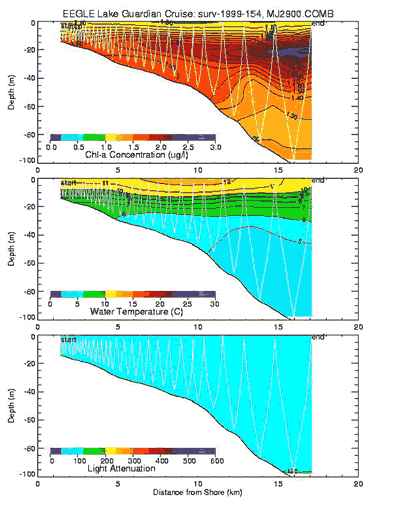
Figure 2C. Muskegon transect in early June 1999: Nominal chlorophyll concentration, water temperature, and light attenuance.
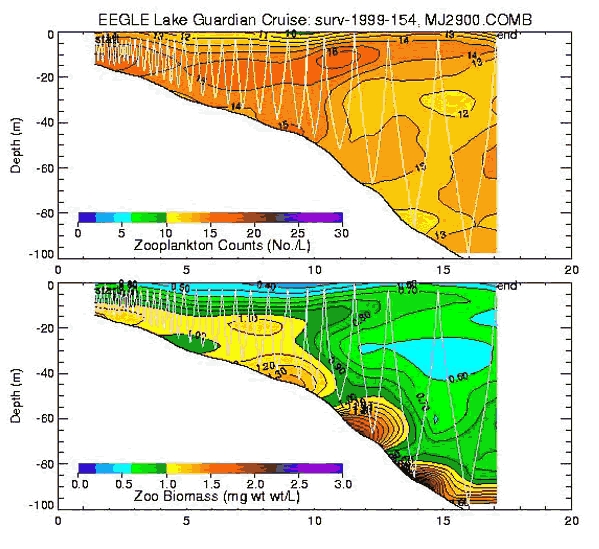
Figure 2D. Muskegon transect in early June: Zooplankton number concentration and biomass.
Products
Data
Publications
Bundy, M.H. H.A. VANDERPLOEG, P.J. Lavrentyev, and P.A. Kovalcik. The importance of microzooplankton versus phytoplankton to copepod populations during late winter and early spring in Lake Michigan. Canadian Journal of Fisheries and Aquatic Sciences 62:2371-23965 (2005). http://www.glerl.noaa.gov/pubs/fulltext/2005/20050024.pdf
Liebig, J.R., Vanderploeg, H.A., and Ruberg, S.A. Factors affecting the performance of the optical plankton counter in large lakes: Insights from Lake Michigan and laboratory studies. J. Geophysical Res.-Oceans. (in press)
Lavrentyev, P.J., Kovalcik, P.A., Cotner, J.B., Johengen, T.H., Vanderploeg, H.A. Beletsky, D., McCarthy, M., and Gardner, W.S. Microzooplankton response to mesoscale episodic events in Lake Michigan. Aquat. Microbial Ecol. (under revision 2005)
Pothoven, S.A., G.L. Fahnenstiel, and H.A. Vanderploeg. 2004. Spatial distribution, biomass, and population dynamics of Mysis relicta in Lake Michigan. Hydrobiologia 522:291-299.
Madenjian, C.P., G.L. Fahnenstiel, T.H. Johengen, T.F. Nalepa, H.A. Vanderploeg, G.W. Fleischer, P.J. Schneeberger, D.M. Benjamin, E.B. Smith, J.R. Bence, E.S. Rutherford, D.S. Lavis, D.M. Robertson, D.J. Jude, and M.P. Ebener. 2002. Dynamics of the Lake Michigan food web, 1970-2000. Can. J. Fish. Aquat. Sci. 59: 736-753.
Vanderploeg, H.A., T.F. Nalepa, D.J. Jude, E.L. Mills, K.T. Holeck, J.R. Liebig, I.A. Grigorovich, and H. Ojaveer. 2002. Dispersal and ecological impacts of Ponto-Caspian species in the Great Lakes. Can. J. Fish. Aquat. Sci. 59: 1209-1228.
Agy, M.A. 2001. Changes in the nearshore and offshore zooplankton communities of southeastern Lake Michigan. School of Natural Resources and the Environment, University of Michigan, 52pp.
Pothoven, S.A., G.L. Fahnenstiel, and H.A. Vanderploeg. 2001. Population dynamics of Bythotrephes cederstroemii in southeast Lake Michigan 1995-1998. Freshwater Biology 46: 1491-1502.
Ruberg, S.A., H.A. Vanderploeg, J.F. Cavaletto, G.A. Lang, J.R. Liebig, T.C. Miller. 2001. Plankton Survey System. Proceedings of the MTS/IEEE Oceans 2001 Conference.
Pothoven, S.A., Fahnenstiel, G.L., Vanderploeg, H.A., and Luttenton, M. 2000. Population dynamics of Mysis relicta in Southeastern Lake Michigan, 1995-1998. J. Great Lakes Res., 26:357-365.
Milestones
FY2001 Henry Vanderploeg: Seasonal mesoscale patterns of plankton along onshore-offshore transects in southern Lake Michigan
Last updated: 2005-12-12 mbl


